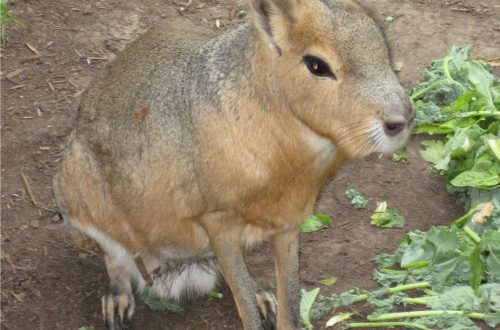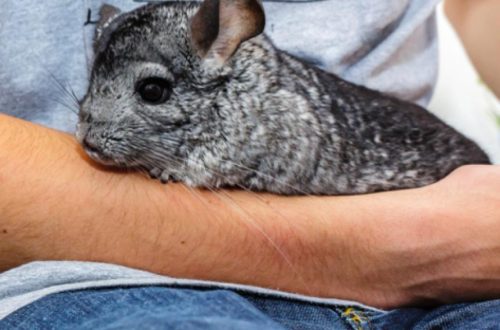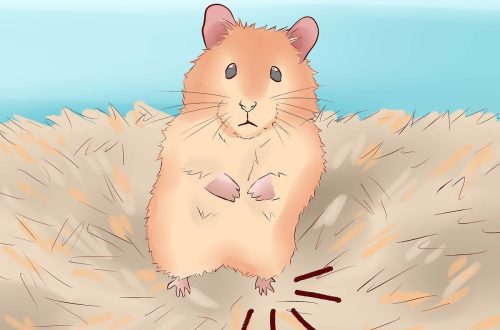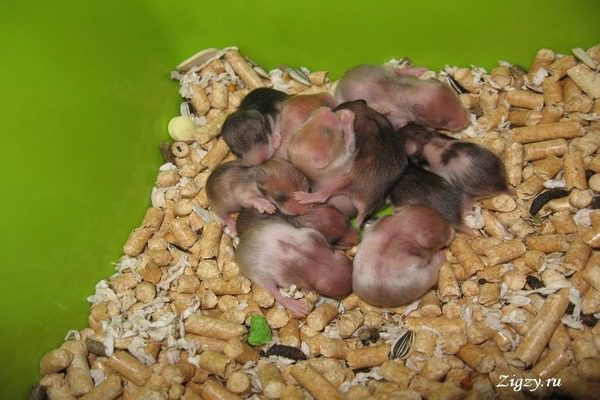
ការបង្កាត់ពូជ hamsters Djungarian នៅផ្ទះ: ពត៌មានអំពីការបង្កាត់ពូជនិងមិត្តរួម
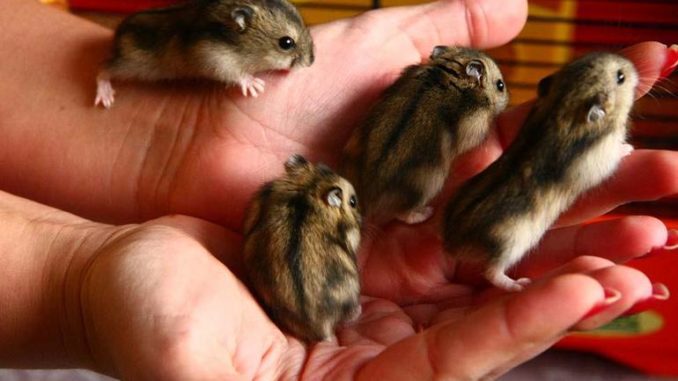
Reproduction of Djungarian hamsters at home sometimes occurs spontaneously – if a couple is kept in the same cage. It is enough to make a mistake in determining the sex when buying young hamsters. It happens that they buy an already pregnant female. Another thing is when breeding rodents is a conscious decision. Then the approach to the issue becomes professional, and the reproduction of jungars is strictly controlled.
មាតិកា
How to breed Djungarian hamsters
Prepare the room
Before mating, cages are prepared for heterosexual young animals, a small carrying for mating. Adult animals are kept in their own cage. It is advisable to have at least one in reserve at home if the offspring cannot be attached in time. Although Djungarian hamsters are much smaller than Syrians, the cage must be at least 50×30 cm (more possible). For the prevention of obesity, hamsters must be provided with a running wheel with a diameter of 16-18 cm. A drinking bowl is required.
In order for newborn cubs to feel comfortable, the temperature in the room is maintained at 21-25 C. The female’s cage should be in a quiet place, in the shade. It is equally important to organize a full-fledged feeding. Rodent breeders strive to create ideal conditions for their pets. This serves as a guarantee that the female will not bite her newborn children.
Buying hamsters
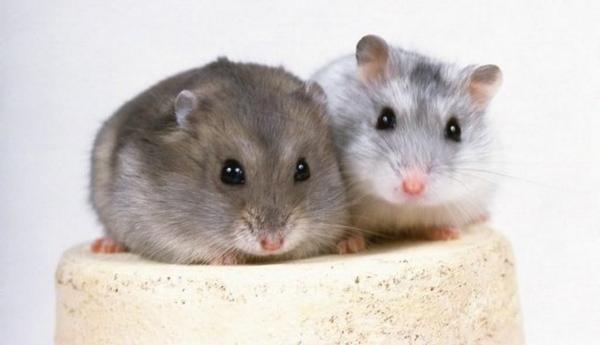
To regularly get offspring, you can keep one male and several females. Animals should not be related to each other. They are purchased from professional breeders or at the exhibition.
When buying at a pet store, it is impossible to trace the origin of rodents, then the male and female are bought in different stores.
Preference is given to animals with a friendly character and ideal external data. The female should not be too small: an individual less than 40 years old runs the risk of not giving birth. The same danger threatens an obese hamster.
Avoid not only closely related crossing, but also interspecific. Djungarian hamsters cannot be crossed with Campbell’s hamsters. Although these dwarf species are very similar to each other and produce viable offspring, there is a risk of large fetuses and complications in childbirth (death of the female). Hybrids cannot be judged on conformation at shows as they do not belong to any species. The Campbells are predisposed to diabetes, and pass the disease on to their offspring.
You will have to distinguish between dwarf hamsters on your own: sellers often call both Sungur hamsters and Campbells “Dzhungar” and Sungur hamsters. It is especially easy to confuse them in the standard color. A distinctive feature of the Dzungarians is the expansion of the black stripe running along the spine, a kind of rhombus on the head.
ការជ្រើសរើសគូ
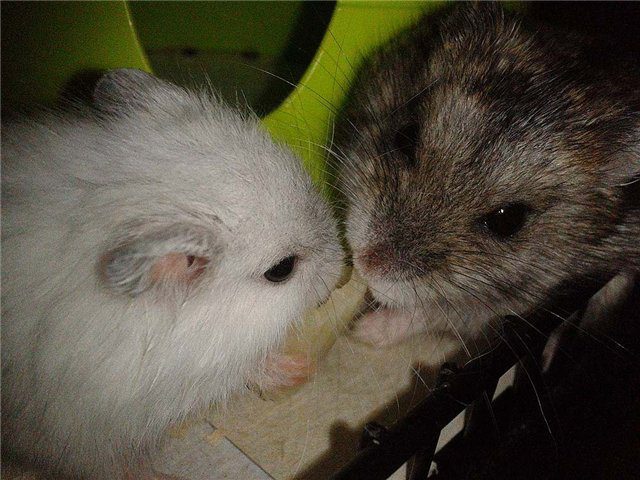
Dzungaria have a limited number of colors, the most common is natural. The eyes can only be black, unlike the Camps. Breeders managed to get unusual coat colors:
- tangerine (reddish, sandy);
- pearl (white with gray);
- sapphire (gray-blue).
Cubs of a rare color are very much appreciated, but when breeding djungarian hamsters with “colored” fur, you need to know the features of genetics.
You cannot breed two mandarin-colored animals, as they will pass on the lethal gene to their descendants. When mating two “pearls”, some of the fruits will also not be viable, so the offspring will be few or completely absent.
The rest of the colors are well combined with each other, giving interesting variations.
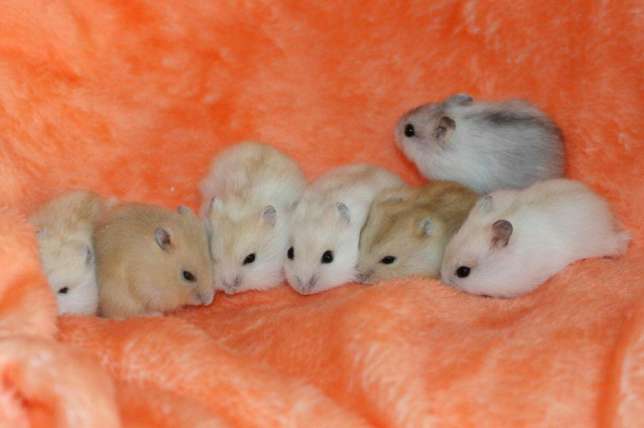
Djungarian hamster: breeding
With a group content, hamsters begin to breed already at the age of 4-5 weeks, but mating of such young animals is highly undesirable. The female is bred for the first time at 4-5 months. Pregnancy lasts 18-22 days, after which the female feeds the cubs with milk for 3-4 weeks. Both gestation and lactation greatly deplete the body. To preserve the health of the mother and obtain a strong offspring, the female is not fertilized for 2-3 months after birth. The hamster will bring 3-6 litters, after which it becomes dangerous to breed her: after a year, the pelvic bones become rigid and the female will not be able to give birth.
The offspring of the Dzungaria is not as numerous as that of the Syrians: the average number of cubs is 4-6 pieces. Babies grow very quickly and at 4 weeks are independent of their mother.
គណនេយ្យ
Significant events are marked on the calendar: mating, childbirth. Record the number and color of the cubs, plan the seating of the young. Immediately after the birth, a date is set when the Djungarian hamsters will go to new owners. Analysis of records helps to identify successful and unsuccessful mating pairs.
How Djungarian hamsters breed
Males and females are kept in individual cages, and mating is carried out on a neutral territory – in a box or carrying. Animals can fight, so the process must be looked after. Sexual hunting in the female occurs every 4 days and lasts about a day.
The difficulty is that the signs of estrus in dwarf individuals are poorly visible. It can be determined only by the reaction of the female to the partner.
Dwarf hamsters – dzungaria and campbells – are not as aggressive towards each other as the Syrian ones. Therefore, you can often hear about cohabitation. This is convenient for the owner: there is no need to organize mating, it is necessary to clean and maintain one cage, not two. But the cons of this approach outweigh the pros.
If there are different-sex jungars in one cell, reproduction cannot be controlled. The female gets pregnant too often. The gestation of the fetus coincides with lactation, the animals die, fight, devour the offspring.
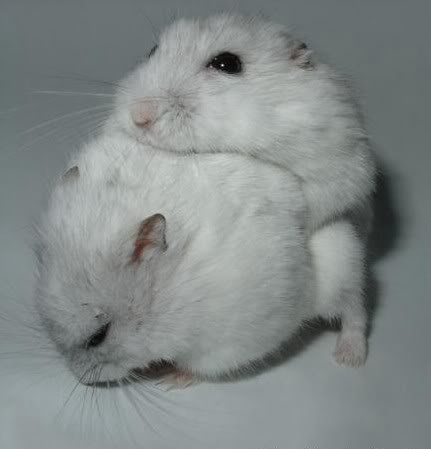
Breeding hamsters dzhungarikov: arguments against
Less life expectancy
A hamster does not live long without that, and in the case of exhaustion of the body by producing offspring, it is almost half as much. If the pet does not die due to the pathology of childbirth, the breeder keeps a female older than a year old, who can no longer make a profit, until her death.
ទំនាក់ទំនងតិច
In order not to provoke cannibalism (eating her own cubs), the female needs to provide privacy. During pregnancy, when the animal is preparing a nest, and then during lactation, it is undesirable to pick up the female or disturb it in any other way. This must be taken into account if the rodent belongs to children.
Requires time and financial investment
Dwarf hamsters will grow wild if the young are not tamed. It is necessary to take hamsters in your hands daily, showing patience and caution. It takes a lot of time, and it is also necessary to organize feeding, change the water, and clean the cages.
Before seating the young, each animal must determine the sex. Hamsters need to find their owners. New owners are interested in many questions about maintenance and nutrition, they will have to be answered by the breeder, unless he sells the cubs in bulk to the bird market.
សន្និដ្ឋាន
Breeding Djungarian hamsters at home can be a very interesting activity. The cattery will not start to generate income until it earns an excellent reputation. Until then, you can only expect that the sale of the offspring will cover the cost of feed and accessories.
Reproduction of Djungarian hamsters
3.9 (78.93%) 244 ការបោះឆ្នោត





